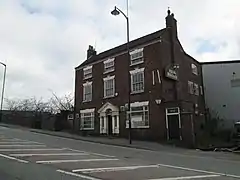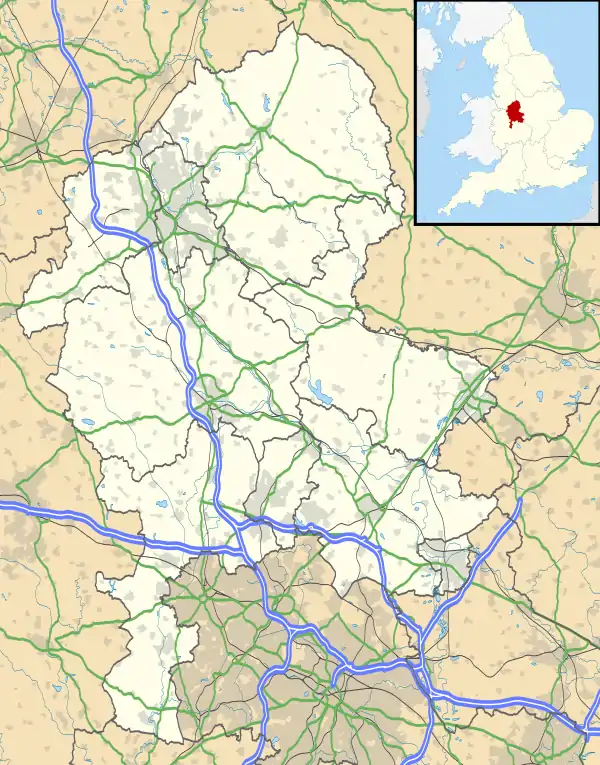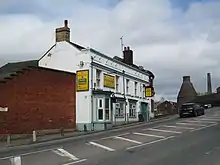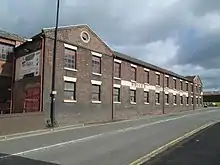Longport, Staffordshire
Longport is an area of Stoke-on-Trent, England. It is the location for Longbridge Hayes industrial estate.
| Longport | |
|---|---|
 The Duke of Bridgewater pub, formerly the master potter's house of Davenport's Pottery | |
 Longport Location within Staffordshire | |
| OS grid reference | SJ858499 |
| Unitary authority | |
| Ceremonial county | |
| Region | |
| Country | England |
| Sovereign state | United Kingdom |
| Post town | Stoke-on-Trent |
| Postcode district | ST6 |
| Dialling code | 01782 |
| Police | Staffordshire |
| Fire | Staffordshire |
| Ambulance | West Midlands |
| UK Parliament | |
Port Vale F.C. played their home games at The Meadows in Limekiln Lane between 1876 and 1881.[1]
Transport
Longport is served by the A500 road (D Road).
Longport is served by Longport railway station which was opened by the North Staffordshire Railway on 9 October 1848 and is regularly served by trains on the Crewe to Derby with a limited number of Stoke-on-Trent to Manchester trains.
History
There were few houses in the area before the completion of the canal.[2] The highway from Burslem to Newcastle passed over a footbridge of planks along the side of a brook, so the area had the name Longbridge.[3] An ancient stone cross once stood at Trubshaw Cross, at the northern end of Longport (now a roundabout at the junction of Newcastle Street and Davenport Street).[2]
In 1777 the Trent and Mersey Canal was completed, and the area acquired the name Longport.[2] The canal was engineered by Hugh Henshall, taking over from his brother-in-law James Brindley after his death in 1772.[4] Henshall managed the main wharf at Longport on the opening of the canal, and built the Pack Horse Inn about 1780, which provided accommodation for boatmen and their horses.[5]

John Brindley, younger brother of James Brindley, established the first pottery factory here in 1773, and other businessmen built pottery factories soon afterwards. John Davenport acquired John Brindley's factory in 1794, and other pottery factories, and the works were enlarged.[3]
In the early 19th century, houses were built for pottery workers. Longport railway station was opened in 1848. In 1858 a new canal bridge was built and the road was widened, and further houses were built.[2]
John Davenport's son William became head of the pottery company in the mid 19th century. His home was Longport Hall, originally built in the 1770s; it was immediately south of Trubshaw Cross.[6] The building was demolished in the 1880s.[2]
Davenport's Top Bridge Pottery was later Price & Kensington.[7] The master potter's house of Davenport's Bottom Bridge Pottery later became the Duke of Bridgewater pub,[8] named after Francis Egerton, 3rd Duke of Bridgewater, for whom canals were constructed by James Brindley.[9]
Demolition

In November 2019, the Price and Kensington Teapot Works in Longport was partially demolished by Stoke-on-Trent City Council, after surveys revealed parts of the structure were at risk of collapse. The derelict building had been on Historic England's Heritage at Risk register. Councillor Daniel Jellyman said "... it is with deep regret that this privately-owned building has fallen into such poor condition... [A] part of the building is in an unsafe and dangerous condition, leaving the city council with no option but to take steps to ensure that the public are not exposed to harm."[10][11] The Grade II* listed building, a former pottery works, is mostly of the early 19th century.[12]
See also
References
| Wikimedia Commons has media related to Longport, Staffordshire. |
- "COMMUNITY CYCLE RIDE". Port Vale FC. 15 April 2009. Archived from the original on 20 April 2009. Retrieved 15 April 2009.
- "Burslem: Buildings, manors and estates", in A History of the County of Stafford: Volume 8, ed. J G Jenkins (London, 1963), pp. 105–121 British History Online, retrieved 30 July 2018.
- John Ward. The Borough of Stoke-upon-Trent, in the Commencement of the Reign of ... Queen Victoria. 1843. Page 155–156.
- "Hugh Henshall" A. W. Skempton, Mike Chrimes. A Biographical Dictionary of Civil Engineers in Great Britain and Ireland 1500–1830. Thomas Telford, 2002. Pages 317–318.
- "Packhorse, Longport in 1991 and 1997". Mervyn Edwards. Burslem Through Time. Amberley Publishing Ltd, 2012.
- Longport Hall thepotteries.org. Retrieved 31 July 2018.
- Listed buildings: Bottle kiln at Price & Kensington, Longport thepotteries.org. Retrieved 31 July 2018.
- The Duke of Bridgewater Inn (Bottom Bridge Pottery) thepotteries.org. Retrieved 31 July 2018.
- Pubs of Stoke-on-Trent: The Duke of Bridgewater – Longport thepotteries.org. Retrieved 31 July 2018.
- "Road closure to allow partial demolition of dangerous structure" City of Stoke-on-Trent. Retrieved 9 November 2019.
- "Stoke-on-Trent listed building partly demolished despite protests" BBC News. Retrieved 9 November 2019.
- Historic England. "Price and Kensington Teapot Works (1290799)". National Heritage List for England. Retrieved 9 November 2019.